How Do to Wire Up 2 Light Switches and One Outlet 1 Feed
1 / 24
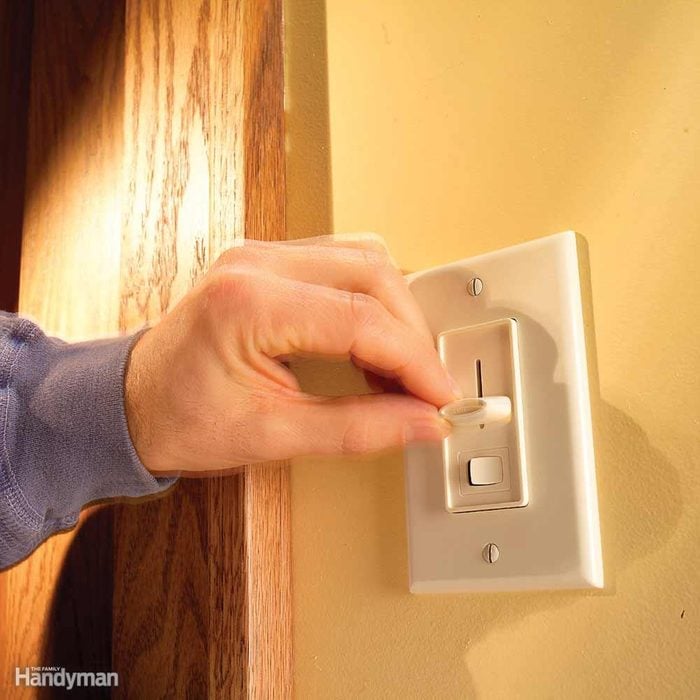
Buying a Dimmer Switch
Dimmer switches are available in many styles and configurations, including slides, knobs and touch-sensitive dimming mechanisms. However, check these key things:
- Capacity (how many lights it can control). The capacity will be measured in watts. Add up the wattage of the bulbs in all the fixtures the switch controls to make sure it falls within the switch rating listed on the package or instructions.
- Single-pole or three-way. Buy a 'single-pole' switch if one switch controls the lights or a 'three-way' if you have two switches controlling the same lights.
- Light type. Standard and halogen bulbs require standard incandescent dimmers. A few fluorescent lights can be dimmed with special dimmer switches, but most can't. Low-voltage lights may also require special dimmers.
2 / 24
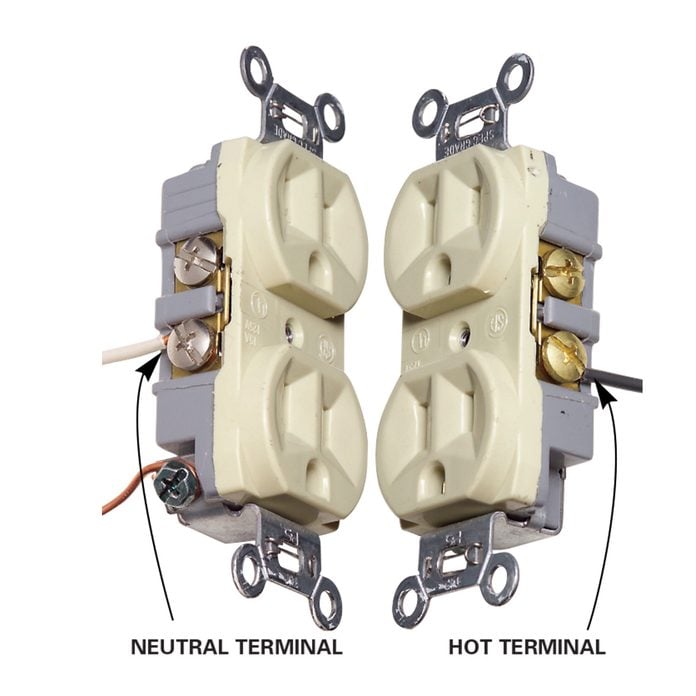
Don't Reverse Hot and Neutral Wires
Connecting the black hot wire to the neutral terminal of an outlet creates the potential for a lethal shock. The trouble is that you may not realize the mistake until someone gets shocked, because lights and most other plug-in devices will still work; they just won't work safely.
Always connect the white wire to the neutral terminal of outlets and light fixtures. The neutral terminal is always marked. It's usually identified by a silver or light-colored screw. Connect the hot wire to the other terminal. If there's a green or bare copper wire, that's the ground. Connect the ground to the green grounding screw or to a ground wire or grounded box.
3 / 24
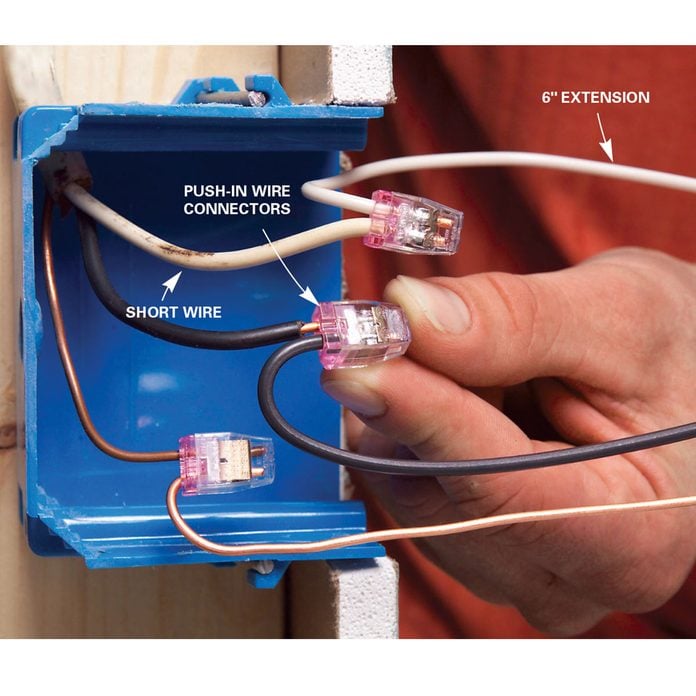
Don't Cut Wires Too Short
Wires that are cut too short make wire connections difficult and—since you're more likely to make poor connections—dangerous. Leave the wires long enough to protrude at least 3 in. from the box.
If you run into short wires, there's an easy fix. Simply add 6-in. extensions onto the existing wires. The photo shows a type of wire connector that's easier to install in tight spots. You'll find these in hardware stores and home centers.
4 / 24
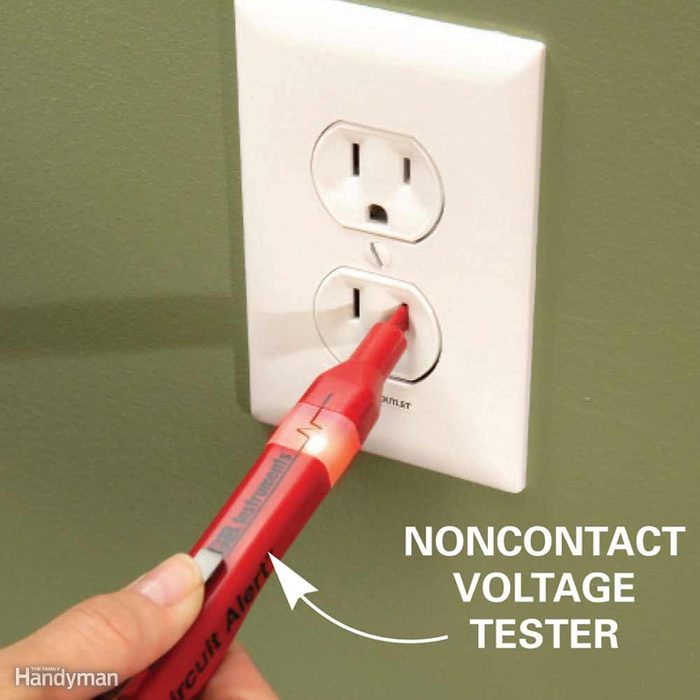
Be Positive the Power's Off
When you're doing electrical work, don't assume that because you flicked a switch or flipped a circuit breaker the power is off—always double-check. Buy a noncontact voltage tester and check all the wires in the box before you do any work—or plan on some melted dental work!
5 / 24

Find Circuit Breakers
Instead of running upstairs, let the Rolling Stones help you find the right breaker. Find circuit breakers by plugging a loud radio into the outlet you're working on. You'll know you have the right circuit breaker when the music dies. But don't assume the electricity is off in all the other outlets or lights in the room. Before doing any wiring, plug the radio into other outlets you plan to work on. Some duplex outlets can have different circuits running to adjacent outlets. To be safe, test both the top and bottom with the radio. For lights, turn the light switch on and off to be sure.
6 / 24
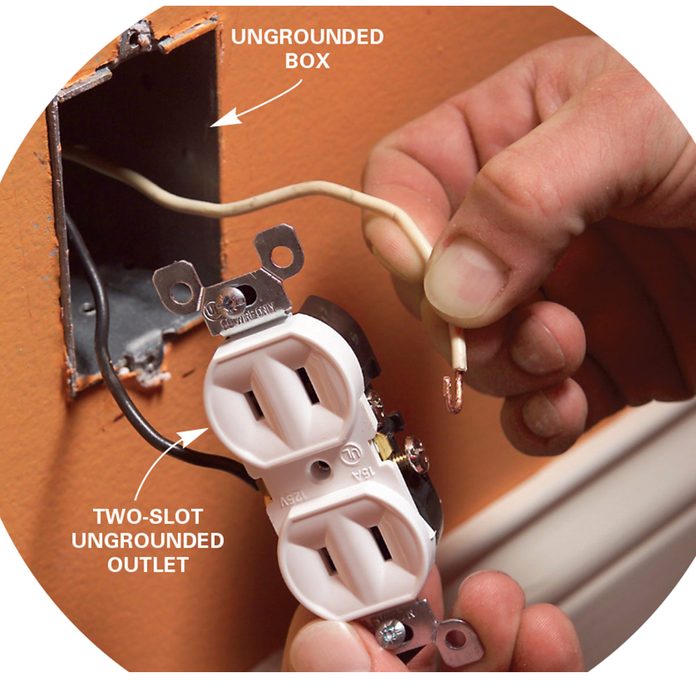
Don't Install a Three-Slot Receptacle Without a Ground
If you have two-slot outlets, it's tempting to replace them with three-slot outlets so you can plug in three-prong plugs. But don't do this unless you're sure there's a ground available. Use a tester to see if your outlet is grounded. A series of lights indicates whether the outlet is wired correctly or what fault exists. These inexpensive testers are readily available at home centers and hardware stores.
If you discover a three-slot outlet in an ungrounded box, the easiest fix is to simply replace it with a two-slot outlet as shown.
7 / 24
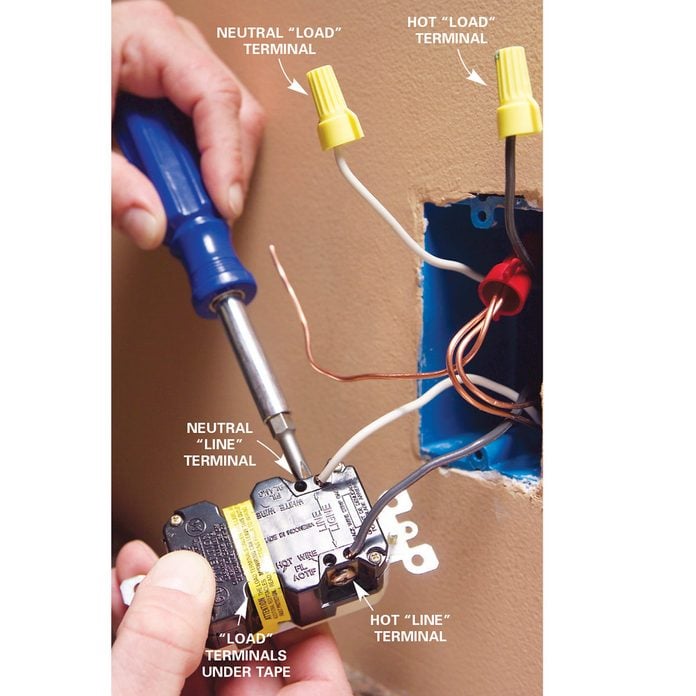
Don't Wire a GFCI Backward
GFCI (ground fault circuit interrupter) outlets protect you from a lethal shock by shutting off the power when they sense slight differences in current. They have two pairs of terminals. One pair, labeled 'line,' is for incoming power for the GFCI outlet itself. The other set is labeled 'load' and provides protection for downstream outlets. You'll lose the shock protection if you mix up the line and load connections.
8 / 24
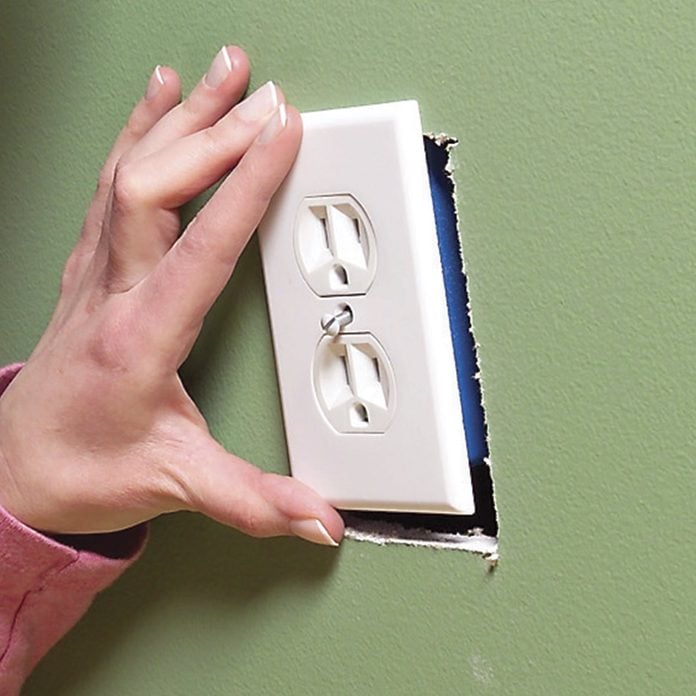
Oversize Plates Hide Mistakes
When you're installing drywall or paneling, small mistakes can leave big gaps around electrical boxes. Luckily, there's a product made just for this situation. 'Oversize' cover plates for switches and outlets are available in standard colors at home centers and hardware stores. They're 1/2 in. to 3/4 in. longer and wider than standard plates, so they can be a bit conspicuous. Electrical codes don't allow gaps wider than 1/8 in. around boxes, so fill gaps with joint compound or caulk before you screw on the cover plate.
9 / 24
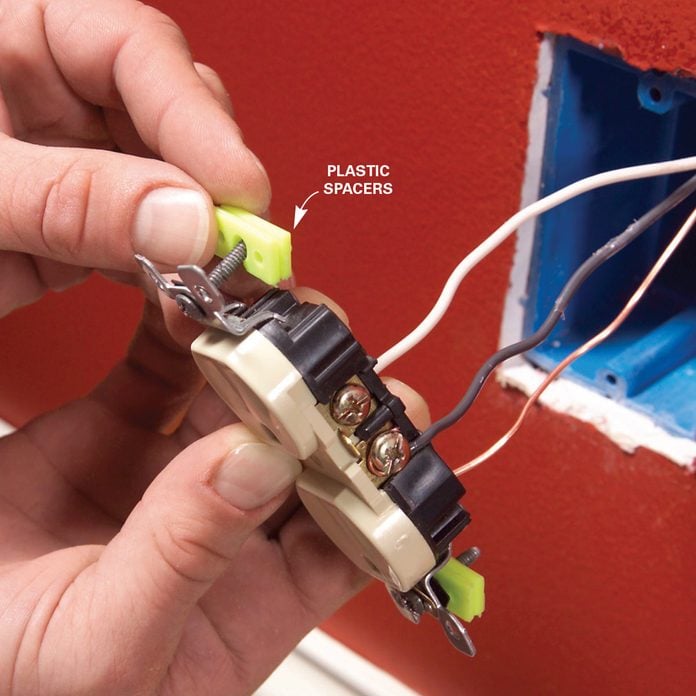
Supply Proper Support for Outlets and Switches
Loose switches or outlets can look bad, but worse yet, they're dangerous. Loosely connected outlets can move around, causing the wires to loosen from the terminals. Loose wires can arc and overheat, creating a potential fire hazard.
Fix loose outlets by shimming under the screws to create a tight connection to the box. You can buy special spacers at home centers and hardware stores. Other options include small washers or a coil of wire wrapped around the screw.
10 / 24
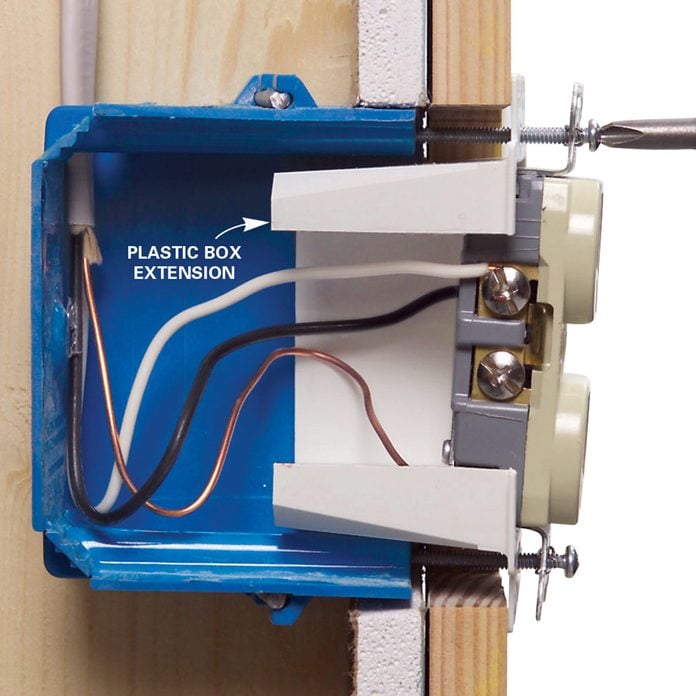
Recessing Boxes Behind the Wall Surface
Electrical boxes must be flush to the wall surface if the wall surface is a combustible material. Boxes recessed behind combustible materials like wood present a fire hazard because the wood is left exposed to potential heat and sparks.
The fix is simply to install a metal or plastic box extension. If you use a metal box extension on a plastic box, connect the metal extension to the ground wire in the box using a grounding clip and a short piece of wire.
11 / 24

Use a Squint-Free Wire Stripper
Ninety percent of the time, you use your wire stripper to strip the same gauge wire. Now, the days of searching your wire stripper for the right size hole are over. Use a Testor's Enamel Paint Marker to mark a line across the hole. After a couple of minutes of drying time, you'll be able to stick the wire in the marked hole with zero eyestrain and work a heck of a lot faster on your latest wiring project. If you're stripping more than one wire gauge size, mark the holes in different colors.
12 / 24

Wrap Wires Clockwise Around Terminal Screws
Wrapping the wire clockwise when wiring a light switch ensures that the loop on the end of the wire will tend to close when the screw is tightened. If you put the loop over the screw in the counterclockwise direction, tightening the screw will force the loop open and could create a loose connection.
13 / 24
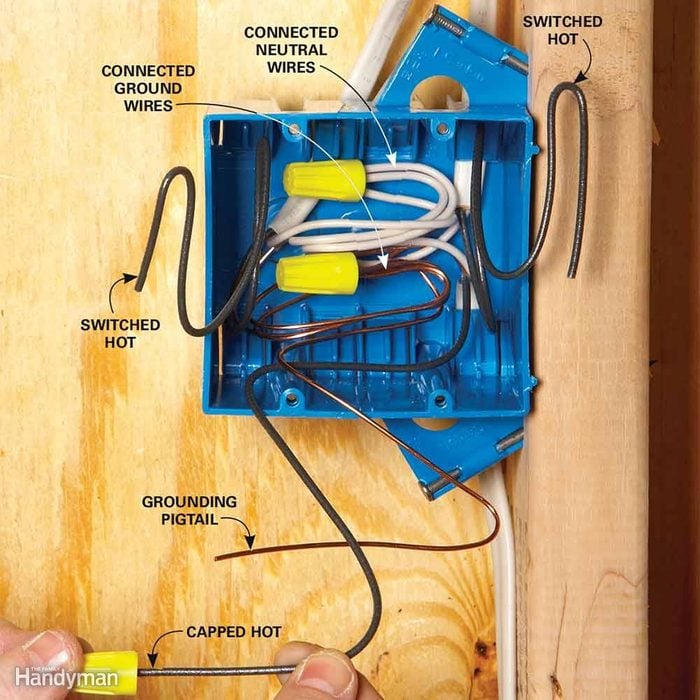
Pack Boxes Neatly
Here's how to keep wires neat and compact: First, gather all the bare ground wires along with a long pigtail and connect them. Fold them into the back of the box, leaving the pigtail extended. Next, do the same for the neutral wires. If you're connecting switches as shown here, you don't need a neutral pigtail. Leave the hot wire extra long and fold it back and forth across the bottom of the box. Put a wire connector cap on the hot wire to identify it.
14 / 24
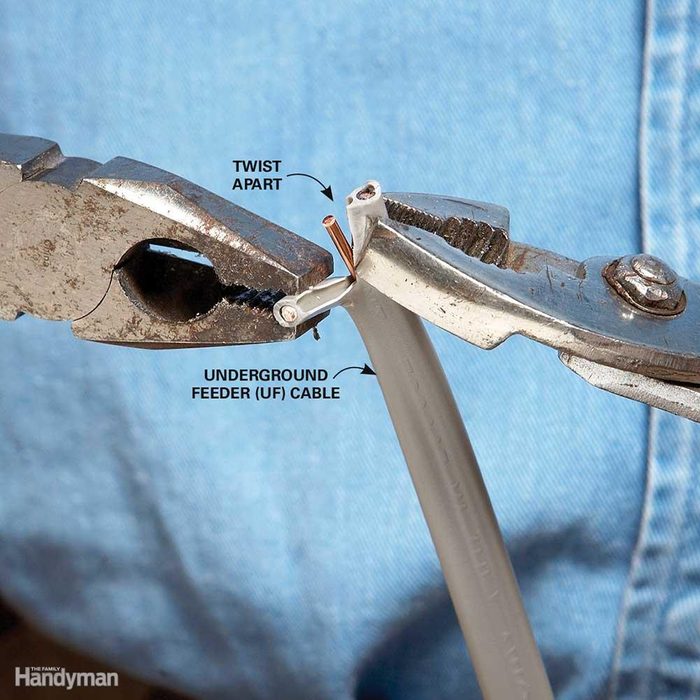
Twist Off Ends of UF
Underground feeder (UF) cable has a tough plastic sheathing that's difficult to remove—unless you know this trick. Start by separating the black and white wires from the bare copper by grabbing each with pliers and twisting. They're easy to tear apart once you get them started. Pull them apart until you have about a foot of separated wires.
15 / 24
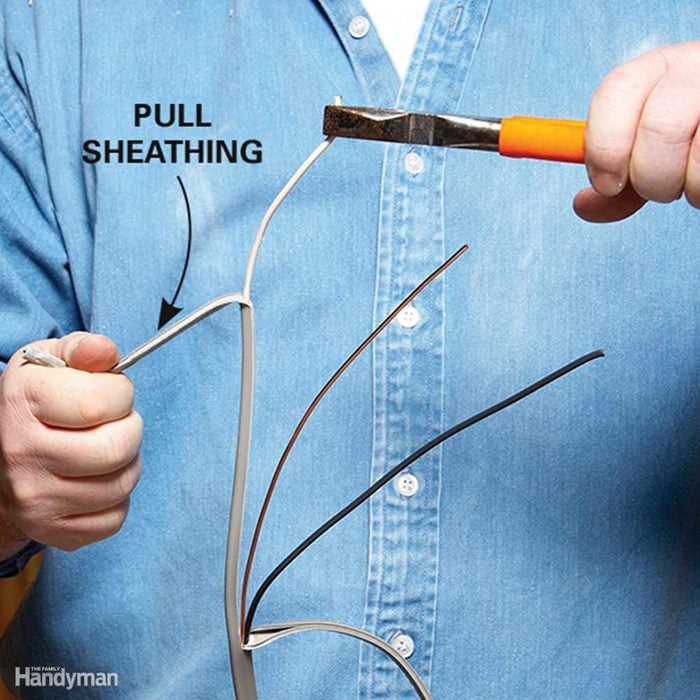
Strip Off Sheathing
Remove the sheathing from the insulated underground feeder wires by grabbing the end of the wire with one pliers and the sheathing with another pliers and working them apart. After you get the sheathing separated from the insulated wire at the top, just peel it off. Repeat the process to remove the sheathing from the black wire. Finally, cut off the loose sheathing with scissors or a knife.
16 / 24
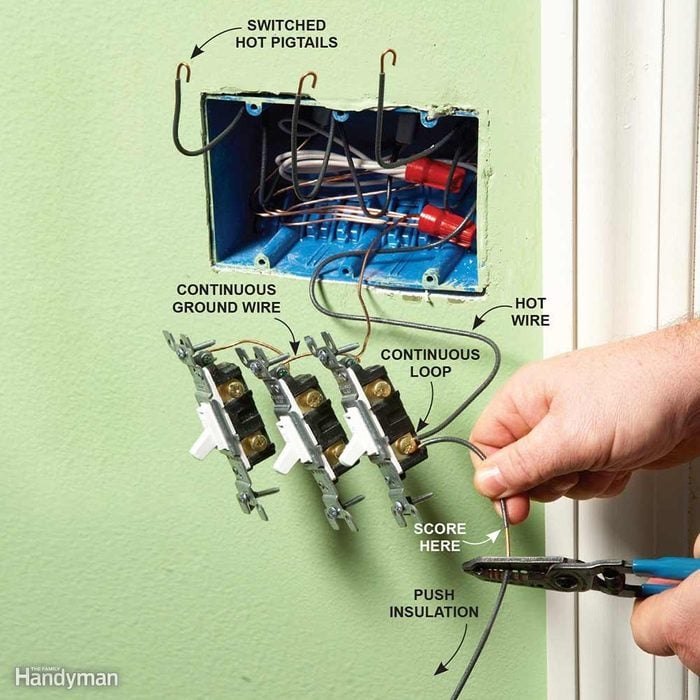
Wire Multiple Lights Together
A box with three switches is crowded enough without adding extra wire connectors and pigtails. Here's a wiring method that eliminates extra connections and creates a neater installation. Instead of running a separate pigtail from the hot wire to each switch, just leave the hot wire extra long. To connect the switches, simply score the wire with your wire stripper and push the insulation to expose about 3/4 in. of bare wire. Connect the last switch in the usual manner, looping the wire around the screw in a clockwise direction.
17 / 24
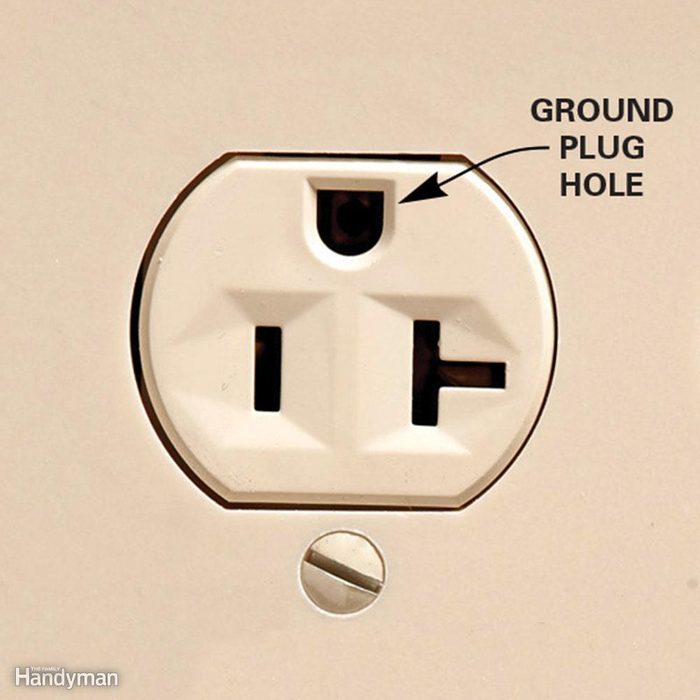
Install the Outlet Up or Down
You usually see outlets installed with the ground hole down. But it's no better than installing them the opposite direction. Electricians endlessly debate this and vigorously extol the virtues of installing it one way or the other, but we'll tell it to you straight—it just doesn't matter. Both ways are correct. The electrical code doesn't specify which direction the ground plug hole needs to face. One way isn't safer than the other—as long as the outlet is wired correctly.
It all comes down to aesthetics, so install them whatever way looks best to you. Incidentally, the ground plug is typically down in the United States, the opposite of how it's generally installed in Canada.
18 / 24
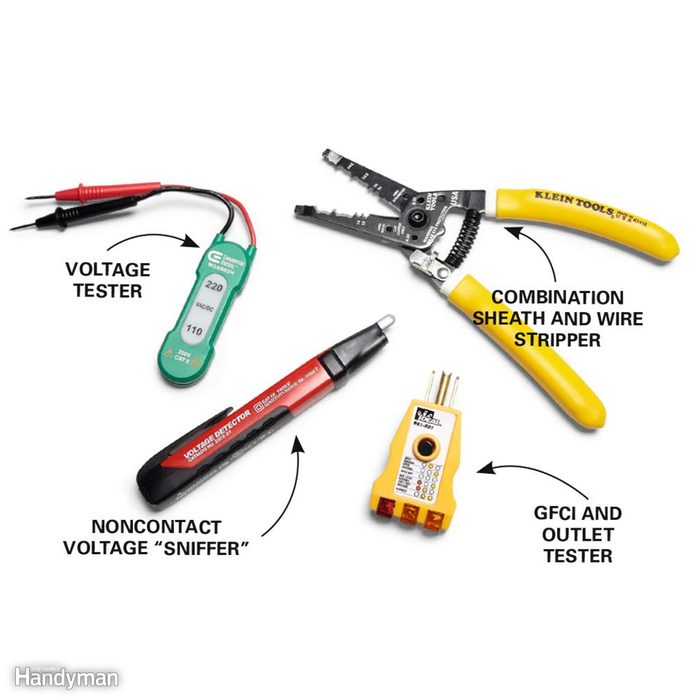
Use Four Key Tools
Here are four must-have tools if you plan to wire many switches and outlets:
- Voltage tester. You can pick one up for a few bucks and use it to test for hot wires or to find a neutral. Just touch the probes between a hot and a neutral, or between two hot wires. The tester will light up if the wires are "hot." The tester shown also tests for 240 volts.
- Combination sheath and wire stripper. In addition to slots for stripping insulation from 14- and 12-gauge wire, it has slots to strip the sheathing from 14- and 12-gauge nonmetallic cable.
- Voltage "sniffer." The beauty of this tool is that you don't have to touch bare wires to see if they're hot. Just hold it near any wire or cable to see if it's energized. Use a noncontact voltage tester like this to double-check that all wires in a box are "dead" after turning off the circuit breaker.
- GFCI receptacle tester. Just plug it into any GFCI outlet and the lights will indicate whether the outlet is properly wired. Plug it into a GFCI receptacle and press the test button to see if the GFCI is working correctly.
19 / 24
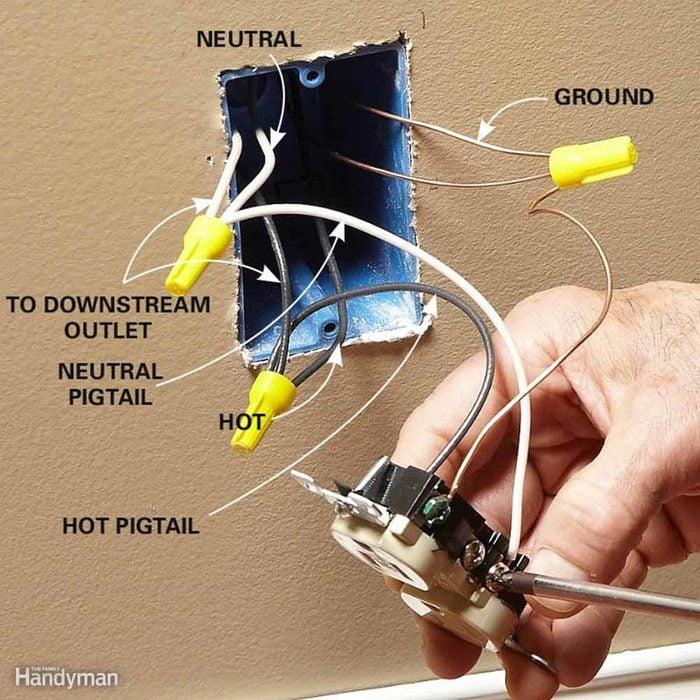
Use Pigtails on Outlets
Outlets have pairs of screws on each side that you can use to connect downstream outlets, but it's best not to use them. There are two reasons for this. First, connecting the wires leading to downstream outlets with wire connectors creates a more secure connection. And second, it's easier to press the outlet back into the box if fewer of its screws are connected to wires. Instead, use wire connectors to connect the neutral, hot and ground wires along with 6-in.-long "pigtails." Then connect the pigtails to the outlet.
20 / 24
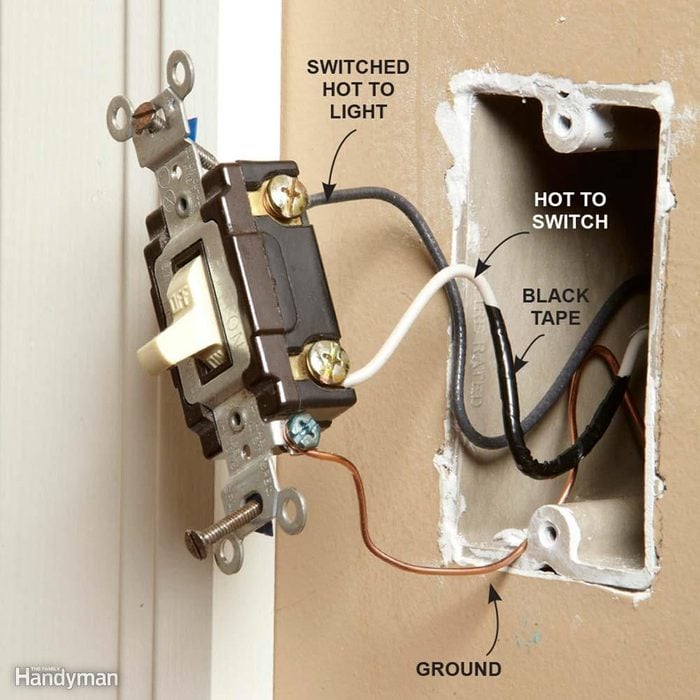
Smart Switches May Need a Neutral Wire
Switch makers have built all kinds of cool features into modern "smart switches." You can buy switches with occupancy sensors, timers and programmable dimmers. But the catch is that, unlike an ordinary switch, some of these new switches require a neutral to operate correctly. This is a problem if your old switch is wired as a "switch loop," such that only a hot and a switched hot are available in the box.
Before you shop for a new switch, remove your old one from the box—after making sure the power is off, of course—and look for a neutral white wire. Any wires connected to the existing switch are not neutral wires. If a white wire is connected to the switch, it should be marked as a hot wire with either a piece of black tape or black marker as shown. If there's no neutral in the box, shop for a smart switch that doesn't require a neutral.
21 / 24
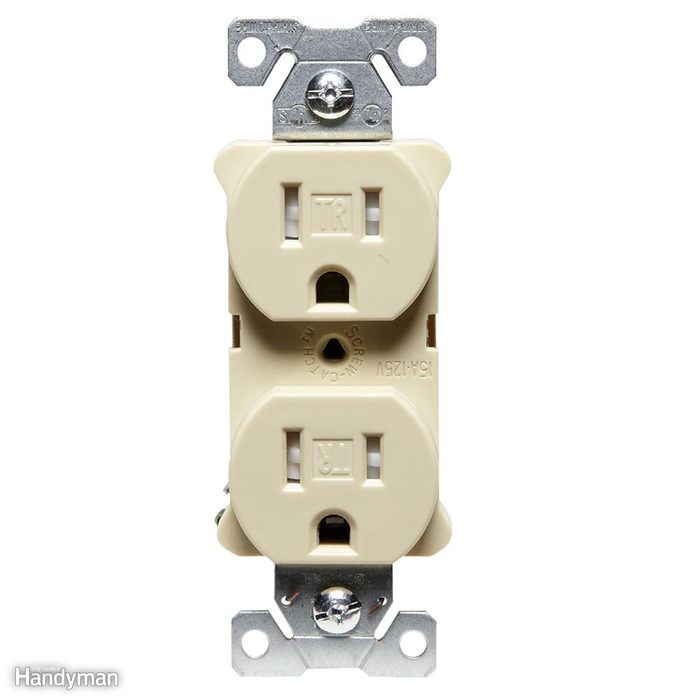
Use a Tamper-Resistant Outlet
In an attempt to reduce the risk of electrocution and fires, the National Electrical Code requires specific types of outlets in certain locations. Tamper-resistant outlets are required everywhere. They have covers over the internal contacts. Before you install a new outlet, check the code or consult with someone who's familiar with code requirements to see which type of outlet you should use.
Weather-resistant outlets are required in certain outdoor locations.
22 / 24
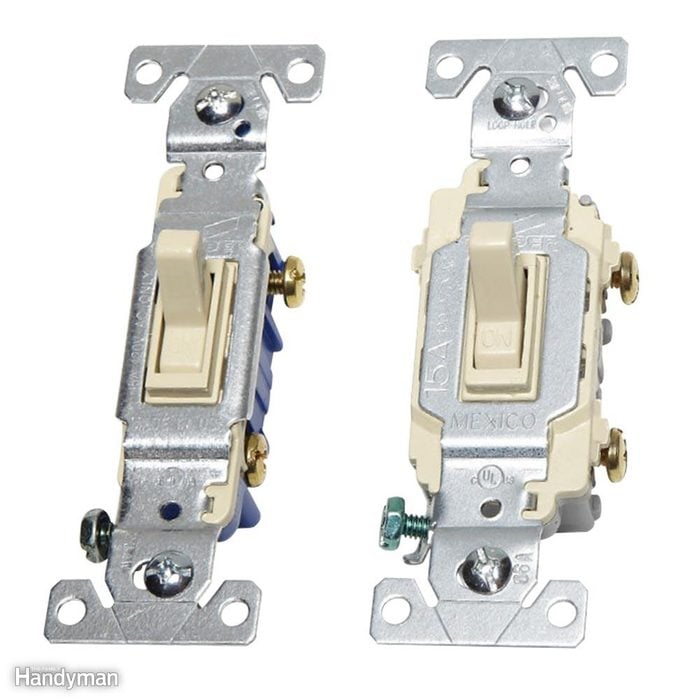
Don't Scrimp on Switches and Outlets
Better-quality switches and outlets may cost a dollar or two more, but they're worth it. For starters, the components are better. They feel more substantial and will last longer. And an added benefit is that many include a "back-wire" feature, not to be confused with cheap "stab-in" connections, which we don't recommend using for wiring a light switch. The back-wire feature still relies on the terminal screw to clamp the wire, but you don't have to bend the wire around the screw. Just strip it, push it in and tighten the screw when wiring a switch.
23 / 24
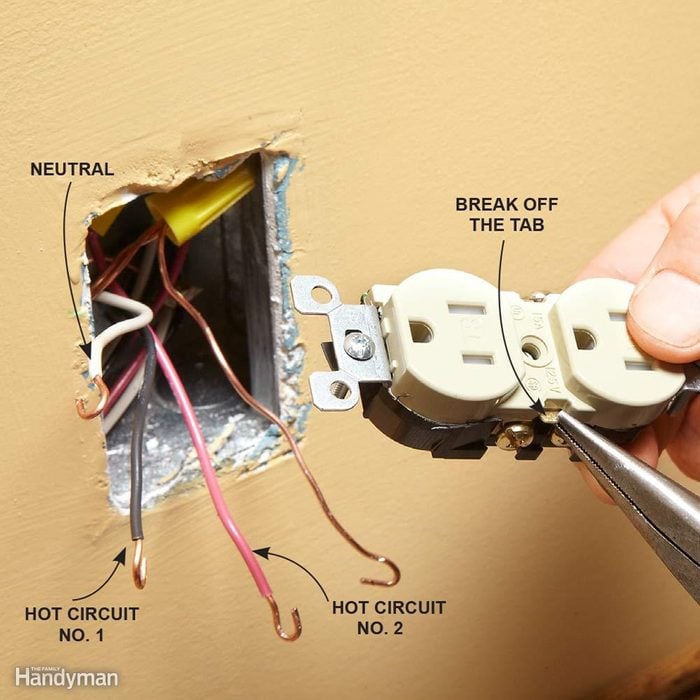
Match the Breakaway Tab to the Original Outlet
There are a few different reasons that an outlet breakaway tab may be removed. If one-half of a duplex outlet is controlled by a wall switch, then the hot tab, and possibly the neutral tab, will be broken off. Or if the top and bottom outlets of a duplex receptacle are powered by two different circuits, the hot tab and possibly the neutral tab will be removed. In any case, when you replace an old outlet, check to see whether the tabs are removed, and if so, break off the tabs on your new outlet to match. Grab the tab with the end of a pliers or your stripping tool and wiggle it up and down to break it off.
24 / 24
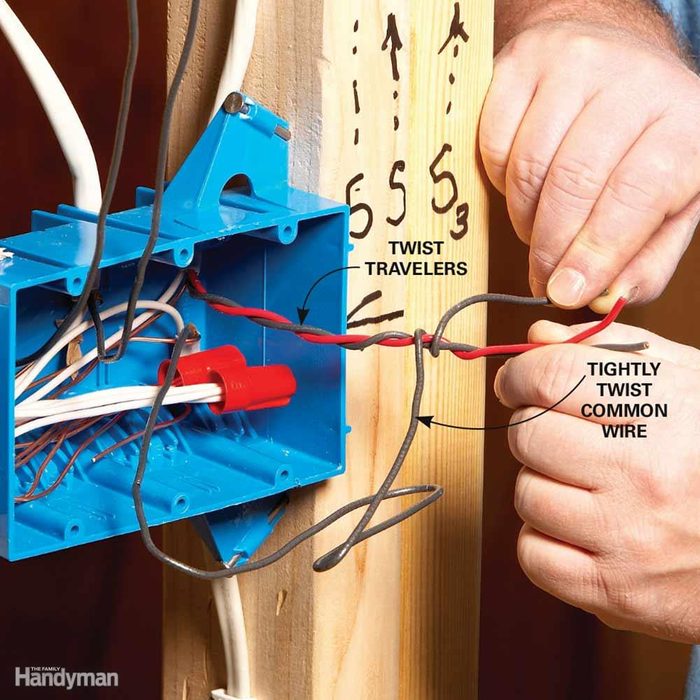
Identify Roughed-in Wires
Save yourself a lot of headaches by identifying the wires as you install them. It's a lot harder to figure out which wires go where when they're covered with drywall after wiring a switch. Many electricians use a "code" for marking wires, and so can you. Here's one example. Wrap three-way switch "travelers" loosely and wrap the common wire tightly around them for easy identification later.
Originally Published: November 15, 2019
Source: https://www.familyhandyman.com/list/wiring-switches-and-outlets/
0 Response to "How Do to Wire Up 2 Light Switches and One Outlet 1 Feed"
Publicar un comentario